As I set my foot inside, I am caught unaware, seeing the durbar in progress. The power of the place engulfing me, I am standing in the courtyard where a celebration is midway. The emperor is seated on the royal throne, the courtesans dressed in heavy colorful silks occupy many bays, facing the Anoop talav. The atmosphere seems to be relaxing and musical. The eagerness and anticipation can be seen on the faces and heard through the hushed voices. I look back from where I had entered.
For the War Heroes – The Bulund Darwaza
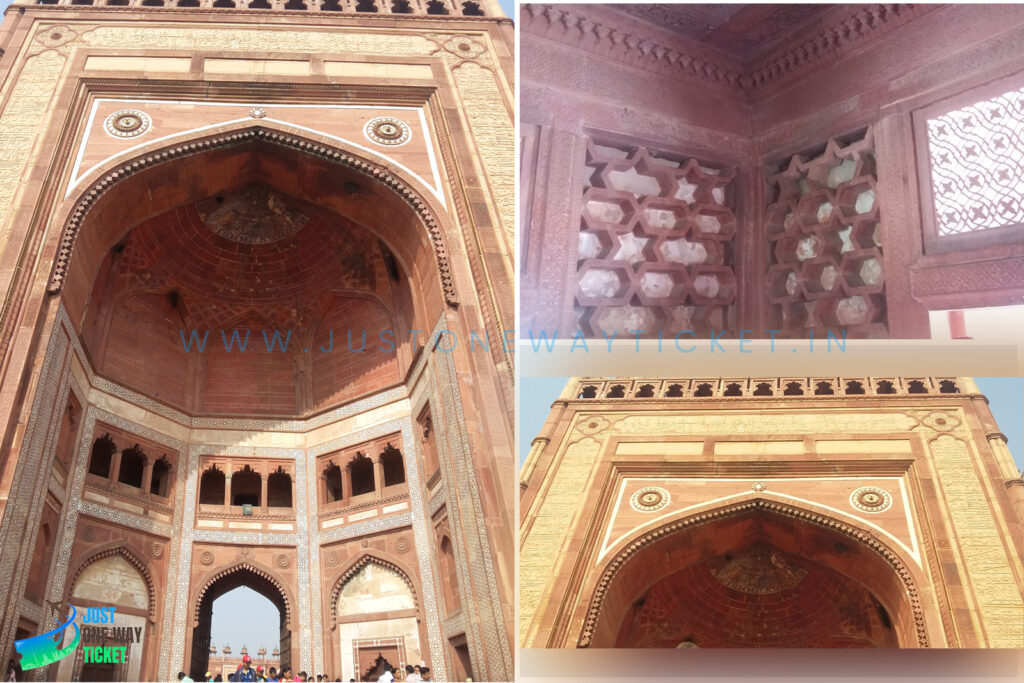
I stand mesmerized in front of a towering 40mts tall edifice. A classic example of Mughal architecture. Bulund Darwaza, the highest gateway of the world, was built to commemorate the victory over Gujrat. What a welcome to the Heroic warriors? the Darwaza is bulund in all senses. My taxi leaving me in high anticipation as to what was inside.
As I ascend the fleet of steps to this massive structure, carved with verses from the Quran and crafted with a floral pattern using marble inlay, the towering structure with many chattris makes it touch the sky, this intimidates me, but outside the Darwaza, the scene is abuzz with hawkers and I am anxious to get inside.
The Love Seat – Anoop Talav
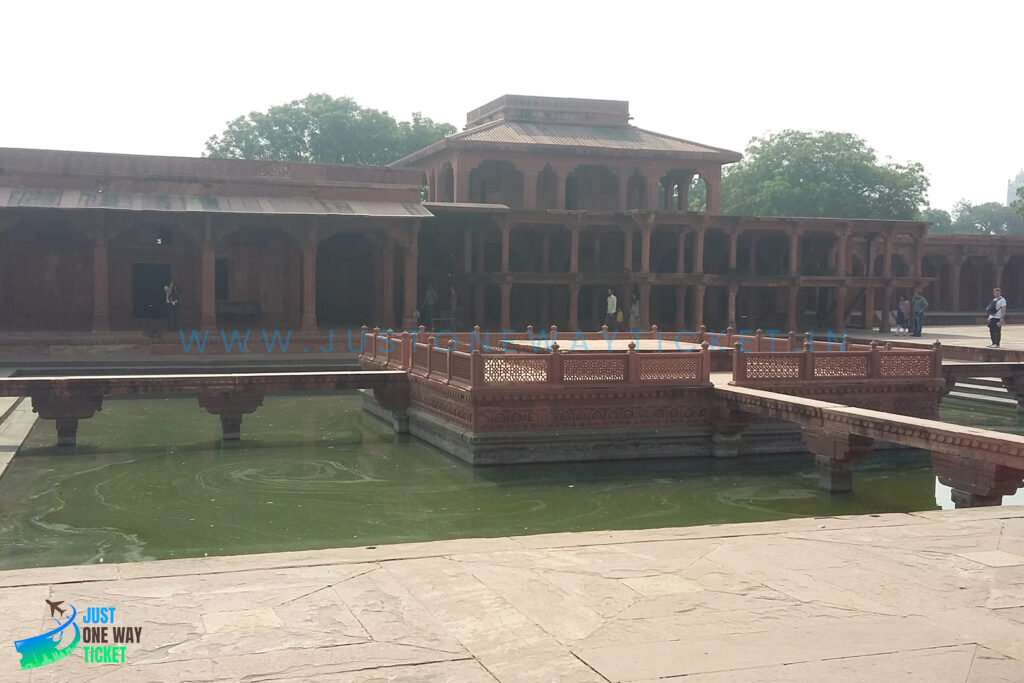
It’s an evening of celebration, the balustrade of the Talav (Pond) is decorated with marigold garlands and, 1000s of lamps are afloat emanating light, enhancing the effect. It’s the Baithak of none other than the royal Singer “TAN SEN” Known for his powerful classical renditions which, could bring the clouds to pour, and lamps to light. It seems it’s an occasion to celebrate at the walled city of “Fatehpur Sikri.”
The dhrupad reverberated from the center stage of Anoop talav. Built on a raised platform and supported on four sides by pillars connected to the main landing by causeways on all four sides.
Identified as one of the most beautiful loveseats, Anoop talav is connected via a waterworks system to the Sukh tal in the North. The fresh water in the talav surrounding the Love seat maintains the temperature and, jali work enamors me. I am lost, in the Drupad and the loveseat. Making a beautiful reflection in the green water of the talav which must be Blue back then, this red sandstone carved structure is packed to glory for the evening.
The Dream Centre – Khawbagh
In the Khawbgah the royal servants are busy tidying the place for emperors’ day-end activity with the Chaitai Curtains are brought down, lamps burn only so much to make proper ambiance making it an atmosphere for a perfect Good night’s sleep.
The temperature of the Khawbagh is rightly maintained from the cool breeze coming from the Anoop talav, the high-rise platform bed with a low ceiling is neatly made, for his highness, but the historical description of his physical stature makes me wonder if he must be using a ladder to climb.
With the first rays of the sun touching the Khawbagh, the emperor seems to have had a great night’s sleep in his royal bed. Still reeling in the dhrupad sung by the royal singer and festivities of the last evening, the emperor has his first sight of the daylight.
The Power Houses of his life
The “sun” the “Mosque “the “Dargah” and Jodha’s Palace. Each one is a powerhouse. The powerhouse of Prayers, blessings, and Love. Making his choices in chronological order, the emperor bows down to the Sun offers his first prayers towards the mosque, pays his gratitude towards the Dargah, and looks for his beloved at the Jodha Palace.
The emperor seems to be regaling in the memories of Son Jahangir’s birth. When all hopes had vanished Salim Chisti a Saint predicted the birth of his son. It seems the couple though apprehensive believed the saint and the day the heir was born, thought of imprinting his birth and the saint’s blessings by building the Walled City Called “Fatehpur Sikri” and Saint Salim Chisti’s Dargah to leave a legacy and hope for would-be mothers.
“City of Victory”
Sikri already existed as a small settlement which was then built as a planned medieval city 450 years ago and with its many edifices is a seamless whole, which was later abandoned for water scarcity. Built in the 16th century Fatehpur Sikri kept Akbar’s descendants entranced. Though inhabited infrequently the deterioration was severe after the decline of the Mughal reign. Built on a ridge the city is also called “City of Victory”
A Powerhouse of Prayers – Mosque
One of the first structures to be planned when the plan of the, would be capital of Akbar was designed, today this is the biggest and most revered mosque and a world UNESCO heritage site. The design resembles Muslim, Hindu, Jain, and Gujarati architectural styles.
The Palaces
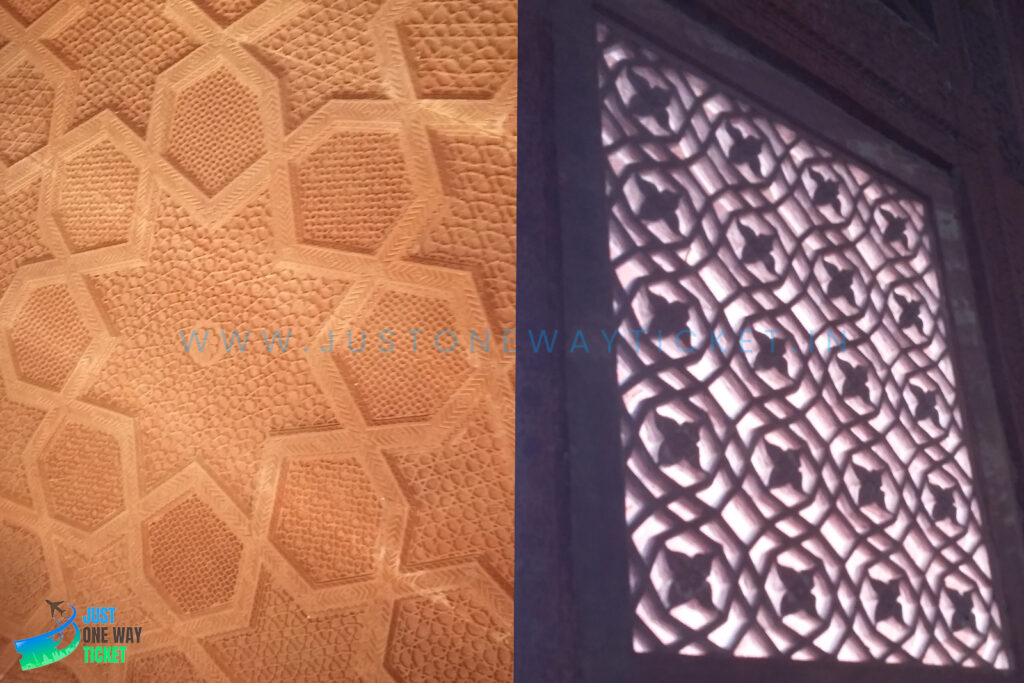
It seems the emperor’s day is packed with state affairs, but giving time to his two-year-old is his priority. Elegantly he walks towards Jodha’s Palace, his royal queen who did not compromise on her religion after marrying Akbar. Her temple-shaped palace is decorated with Jharokas for Hindu deities and lamps. Her palace with the other two palaces of the emperor’s Muslim and Christian Queen and most of the edifices in the walled city are decorated with rich silk, satins, and stones. The times speak of the grandeur, rich trade, and commerce of the Era.
Ibadat Khana
The troupe of ministers is ready for the formal day to begin and his trusted courtier reminds him about the many saints waiting for a discussion on the religious affairs of all sects. The emperor seems to be looking forward to a multicultural hour or so ahead at The IDGAH. A unique quality of his highness to give an Ear mindfully. Akbar has spent way more time than planned and he has to attend the next meeting at the Diwan-E-Aam
For Public – Diwan-E-Aam
The Diwan-E-Aam is jam-packed as the public plea interest the citizens of Sikri and all are eager to hear from the emperor. About 100 and more small cubicle-like structures to accommodate the visitors and a raised platform forming the seat of the emperor, surrounded with the open spaces to accommodate large crowd is the Diwan-A-Aam.
For Royals – Diwan-E-Khas
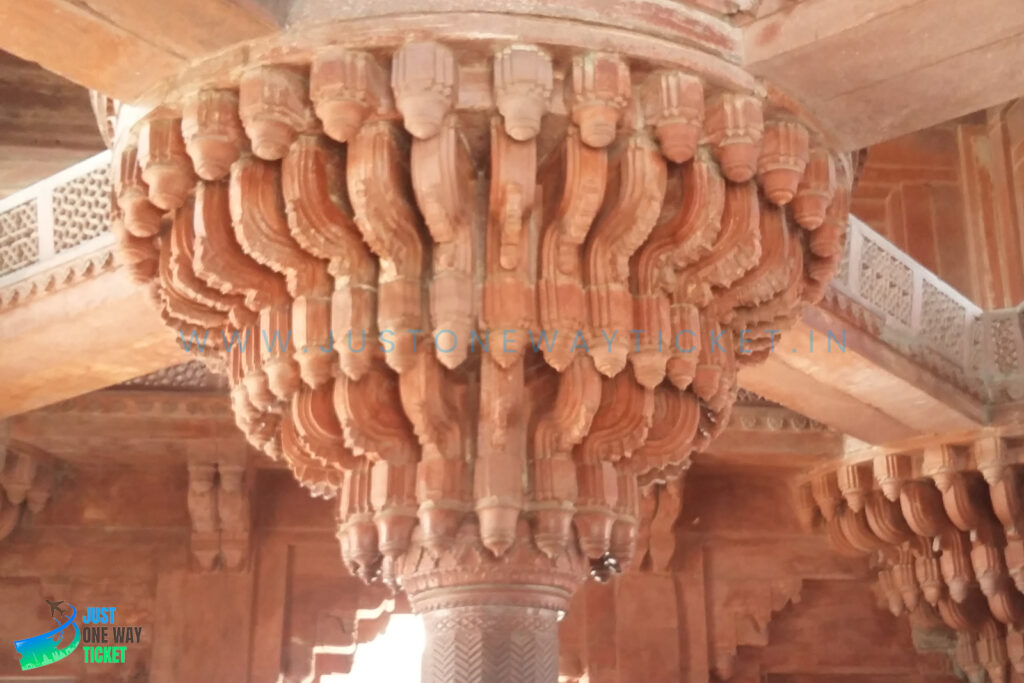
The matter discussed here seems to be a family affair and is full of the royal family. With women behind the beautiful Jharokas keeping the purdah system in mind, this is a structure with an ornately crafted central pillar connected by causeways on four sides which has a place for the Nine Navratans to sit.
Yes, The Akbar’s Navratnas are very well known and were his chief advisors. Known for the patronage of Scholars, Saints, Musicians, and Artisans though illiterate he was known for a powerful entourage. His specific gathering today before solving the grave matter of state affairs does discuss the last night’s celebrations and Tansen’s dhrupad, starting the discussion on a lighter note.
Recreational – Panch Mahal
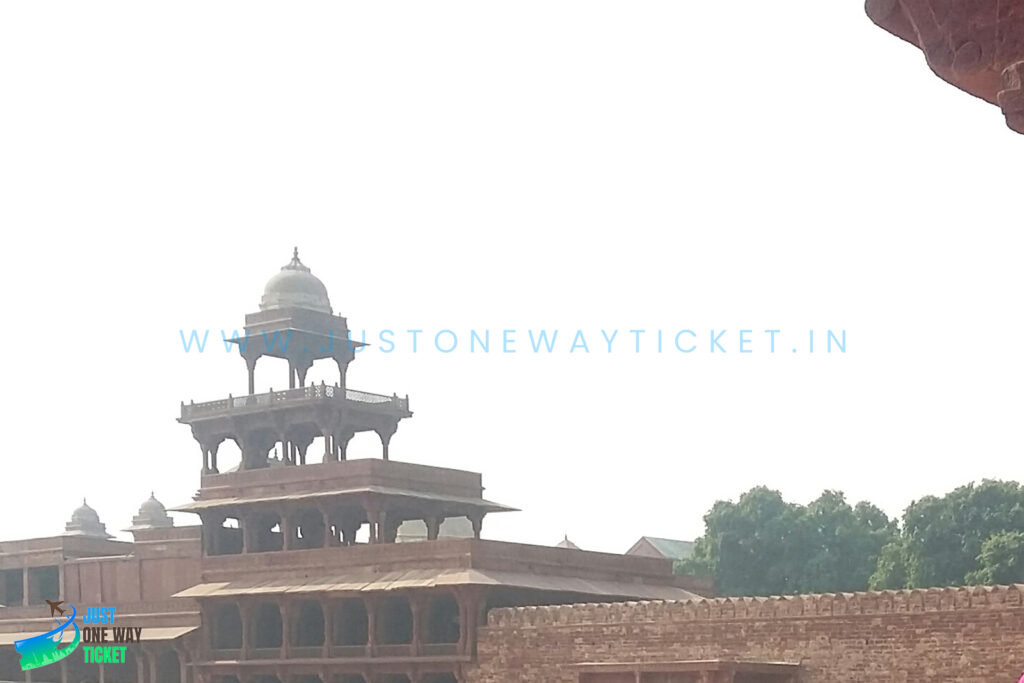
The day is over and he moves on to the recreation Complex called the Panch Mahal. The fascination for creating beautiful structures makes the emperor marvel at his passion and precision, as he walks tall towards the Panch Mahal he feels proud. With five stories descending towards the top.
Panch mahal with 176 pillars and intricate jail work and chattaris is a stunning building. Used for recreation and one can hear the giggles and laughter reverberating from it, and this brings smiles on the emperor’s face too. The top floor that’s the fifth is the vantage point for Akbar to look at his creation, the walled city. The carved pillars and the artwork done with precision keep you engrossed.
His trusted Hand – Birbal’s Palace.
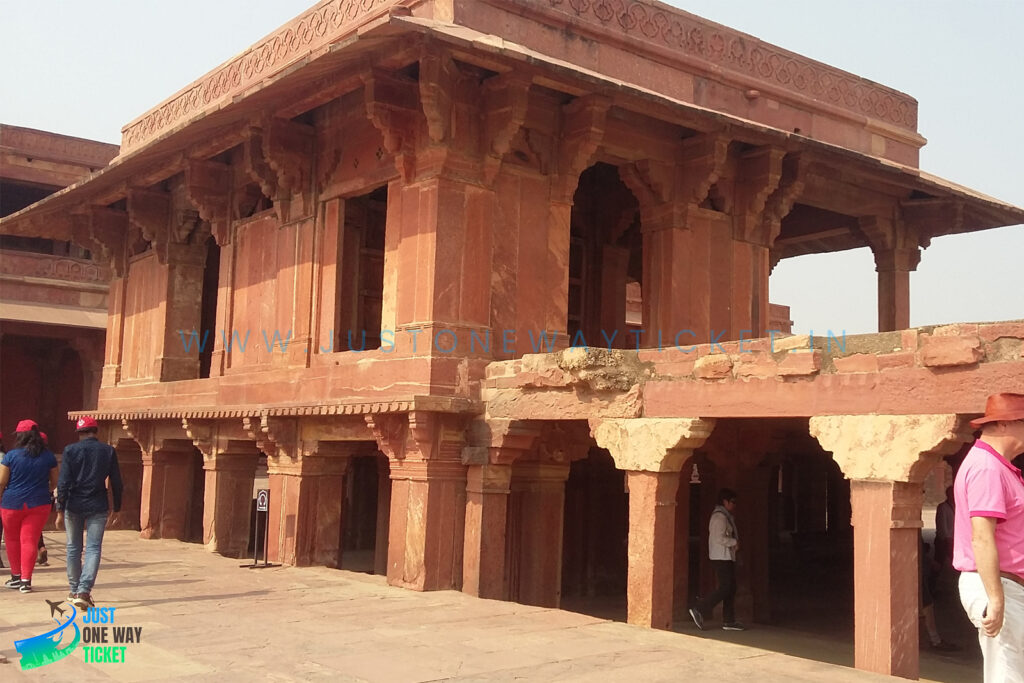
Fondly from there he also eyes Birbal’s palace. The witty minister and one of his treasured Navratans occupy a small palace in the walled city. Remembering an anecdote which he had just recently shared with Birbal and both having a heart full laugh, which once again brings a smile to his face.
Blessings – Salim Chisti’s Tomb
Akbar’s day ends by bowing down at the Dargah and seeking blessings. The Dargah was initially made in red stone later made in marble in the reign of Jehangir and is the only building made in marble. The place is pristine and pious and made of jalis/walls of geometrical and floral designs in marble. The evening sun casts its rays through the jali thus enlightening the tomb sitting snugly in an ornamented wooden canopy. The Sufi songs can be heard, and the atmosphere is somber. I understand what hope means and the power of the word.
Whims and Fancies
I fancy this whim of Akbar, I seem to somewhat understand why he made the “City of Victory” Must have been overwhelmed with the happenings, birth of his successor, victory over Gujrat, expansion of his empire and I am sure there must be lot other reasons for the WHIM and Fancy. This can only happen when you have the power and the resources. Akbar was blessed with unique innate qualities. I am overwhelmed too, I live and dream and visualized him walking the city and I thoroughly enjoyed spending a day being a part of the entourage.
Loved the silks and satins, smelled the essences from the Dargah, enjoyed the dhrupad, and felt Rich with experiences. Automatically this came to my Mind for Akbar…. “Murti Lahan pan Kirti Mahan” Yes ruled India and we might or might not have done better, but the imprints of the Mughal Empire are engraved throughout.
The Walled City, surrounded by lush Green lawns today is a World UNESCO site and definitely, a heritage and a must-visit day destination when doing the Golden Triangle. Stay tuned to Varsha Mahore Blogs. Enriching lives through Travel.
To live your imprint by connecting with me on my website www.justonewayticket.in social media handles.


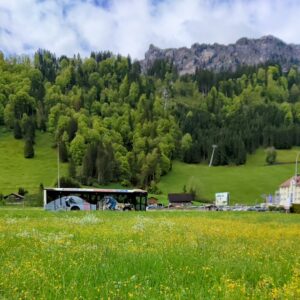
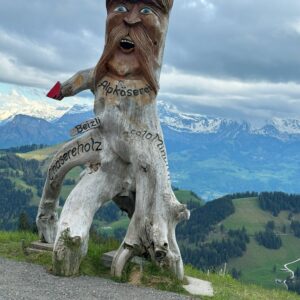
It’s an excellent piece of information making me aware about multiple facets of the historical town.
I literally felt that I am strolling across the place.
The old Urdu/Persian names like ” Ibadat khana” & likes are so soothing to read & imbibe.